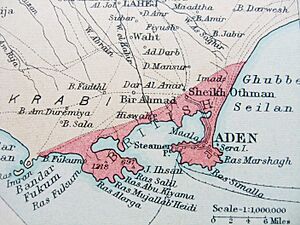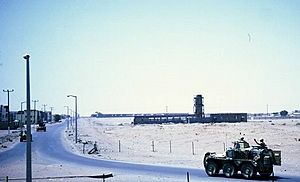State of Aden facts for kids
Quick facts for kids State of Aden
ولاية عدن
|
|||||||||
|---|---|---|---|---|---|---|---|---|---|
| State of the Federation of South Arabia | |||||||||
| 1963–1967 | |||||||||
|
Flag
|
|||||||||
 Map of British Aden (1922) |
|||||||||
| Capital | Aden | ||||||||
| Area | |||||||||
|
•
|
192 km2 (74 sq mi) | ||||||||
| History | |||||||||
|
• Federation of South Arabia established
|
18 January 1963 | ||||||||
|
• State of Aden disestablished
|
30 November 1967 | ||||||||
|
|||||||||
The State of Aden (Arabic: ولاية عدن Wilāyat ʿAdan) was a special area in Aden. It became part of the Federation of South Arabia on January 18, 1963. After this, Sir Charles Johnston stopped being the last British Governor of Aden.
People hoped that joining the Federation would bring peace. However, fighting and protests in Aden grew worse. This led to the British leaving the area by the end of November 1967.
On November 30, 1967, the State of Aden became part of a new independent country. This country was called the People's Democratic Republic of Yemen, also known as South Yemen.
History of Aden's Formation
The Colony of Aden faced many challenges. To solve these, and to help Aden become more self-governing, a plan was made. The idea was for the Colony of Aden to join with other areas called protectorates (areas protected by Britain). These areas were known as East and West Aden.
People hoped that forming a federation (a group of states working together) would help reduce calls for complete independence. It was also hoped that Britain could still control its foreign affairs and a large oil refinery in Little Aden.
Ministers from both the colony and the protectorates first suggested this federation. They believed it would be good for the economy, and because people shared similar backgrounds, religions, and languages. However, this step was not popular with many local Arabs, especially trade unions (groups of workers). They felt it went against their desire for full independence.
Another problem was that Aden Colony was quite modern in its government. But the sultanates (areas ruled by sultans) in the protectorates were much older in their ways. Some people thought joining them was a step backward.
In the new federation, the former Aden Colony was given 24 seats on the main council. Each of the eleven sultanates from the former Aden Protectorate received six seats. Britain promised to give money and military help to the whole federation.
Aden Emergency: A Time of Conflict
Many of the problems Aden had as a colony did not get better when it became a federated state. The Aden Trade Union Congress (ATUC), a powerful workers' group, had a lot of influence in the new government. To stop them from gaining too much power, the former Colony of Aden joined the Federation of South Arabia in 1962. This was so that pro-British members from Aden could balance the ATUC's influence.
However, soon after Aden joined the federation, a big change happened. The ruler of the Yemenese monarchy was overthrown. This led to a civil war (a war between groups within the same country). One side was supported by Gamal Abdel Nasser (from Egypt), including a group called the National Liberation Front (NLF). The other side, the monarchists, were supported by Saudi Arabia and the United Kingdom.
Trouble continued and grew worse. On December 10, 1963, a state of emergency was declared in Aden. This meant the government took special powers to deal with the serious unrest. This period became known as the Aden Emergency.
Other important events happened during this conflict. One was the Battle of the Crater. This battle made a British officer named Lt-Col Colin Campbell Mitchell (also known as "Mad Mitch") famous. On June 20, 1967, there was a mutiny (a rebellion) among soldiers in the South Arabian Federation Army, which also spread to the police. British forces, especially the 1st Battalion Argyll and Sutherland Highlanders led by Lt-Col Mitchell, helped bring back order.
Despite this, dangerous attacks against British forces continued. These were mainly carried out by the Egyptian-supported National Liberation Front (NLF). The British presence in Aden finally ended when their troops left. This departure happened earlier than planned by British Prime Minister Harold Wilson. It meant the future country was left without a clear plan for who would rule next. In the end, the NLF, who were against the State of Aden and the Federation, managed to take control.
On November 30, 1967, the State of Aden and the federation became the People's Republic of South Yemen. Unlike some other former British areas, this new independent state did not join the British Commonwealth (a group of countries mostly linked to the British Empire).
See also
- Aden Protectorate
- British Forces Aden
- Aden Emergency



